Butterflies are known for their colored wings. These wings can sometimes make them look like leaves. Some of them are so similar to leaves that they’re even confused with a leaf. Oakleaf butterflies are commonly confused with the leaves of oak trees.
Here are a few common butterflies that look like leaves.
Table of Contents
1. Dry-leaf Commodore
The Dry-leaf Commodore butterfly (Precis tugela) is known for its wide wingspan that can reach up to 64mm.
Male butterflies have a shorter wingspan of up to 60mm.
This species is common around Africa where it’s constantly confused with leaves.
Its wings are brown and yellow. This butterfly also has brown dots on its wings which further make it difficult to notice when sitting on fallen tree leaves or tree bark.
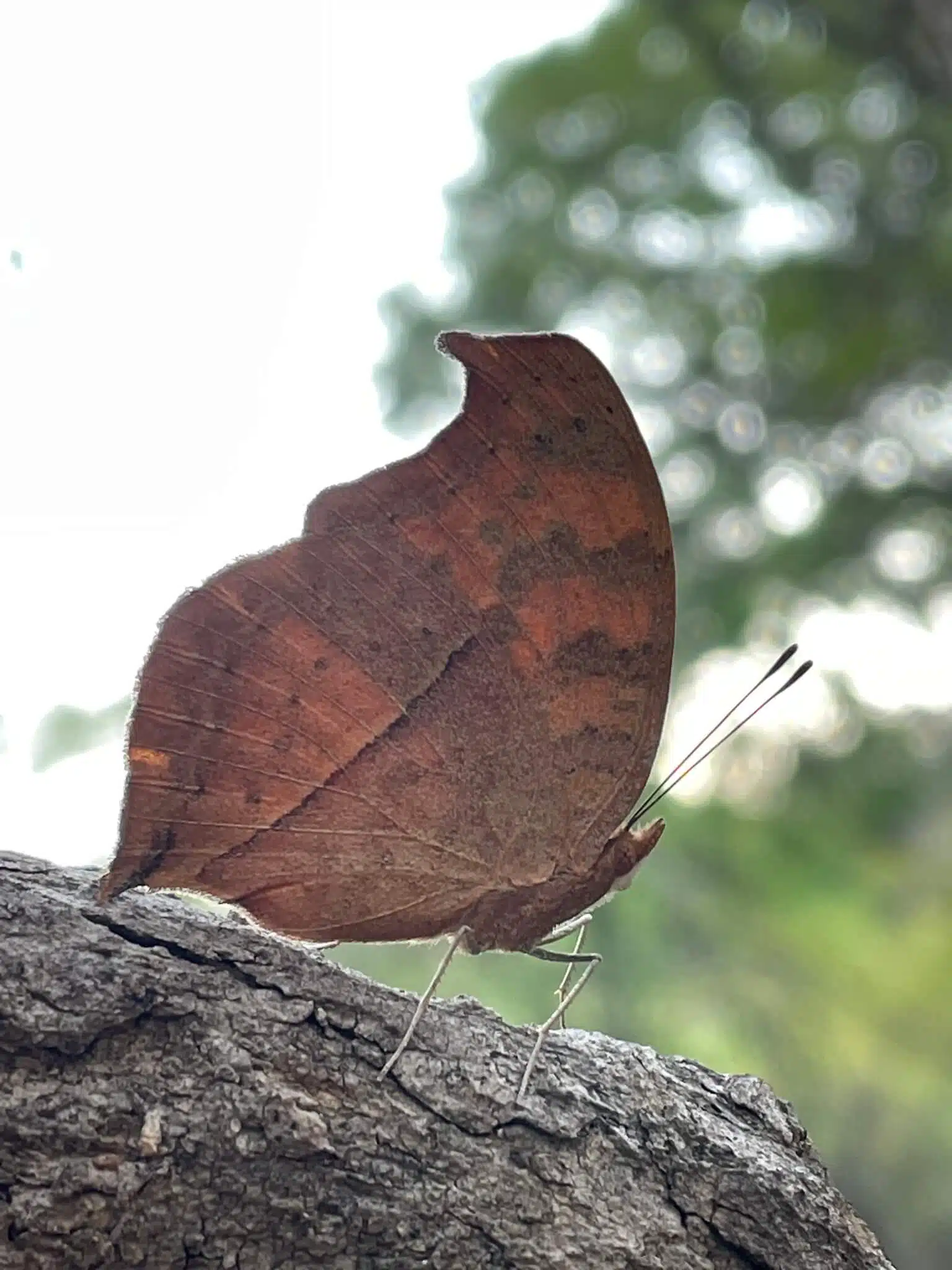
2. Purple Leaf Blue
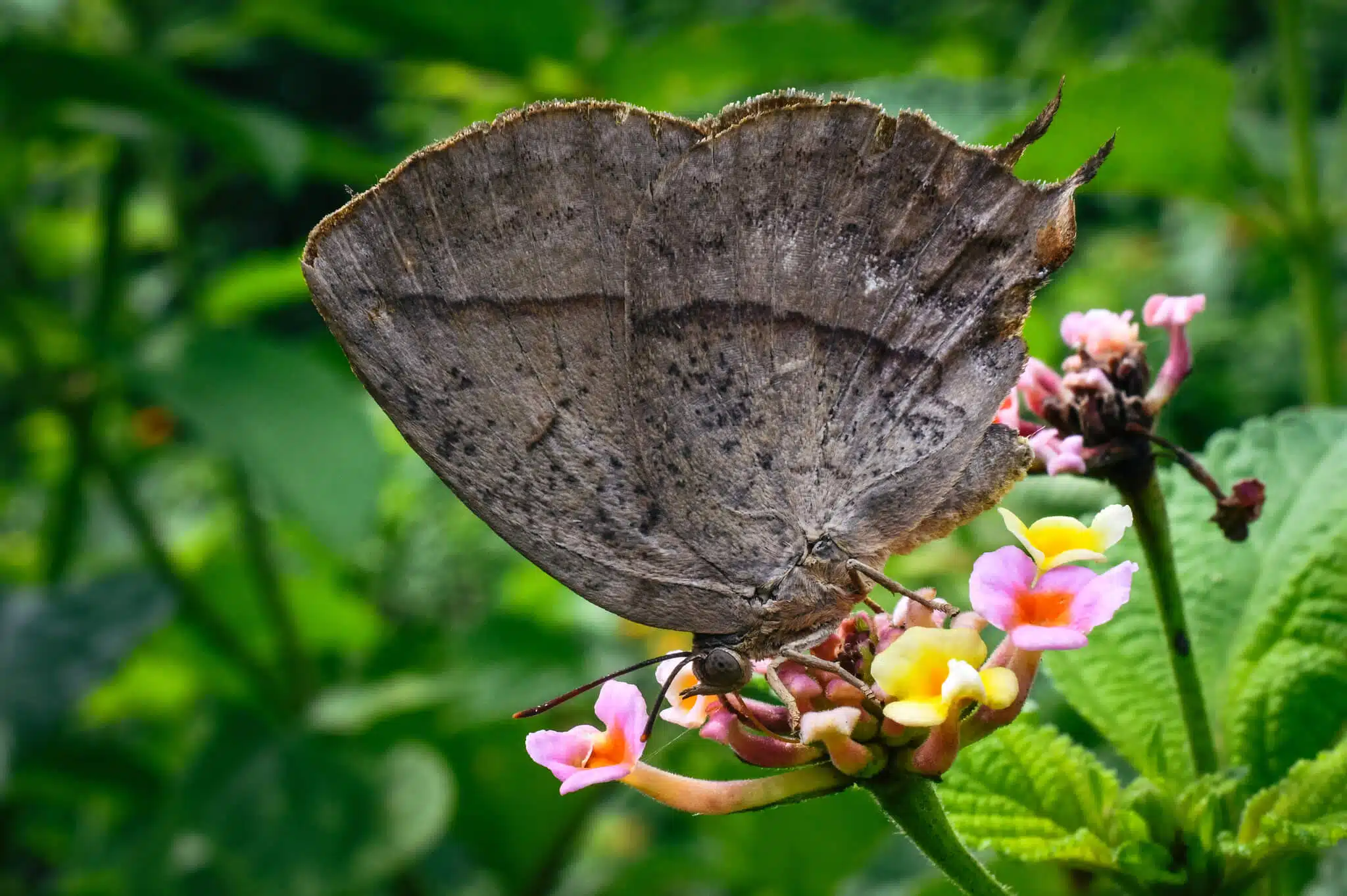
Purple Leaf Blue butterflies (Amblypodia anita) are common in Southeast Asia. These butterflies are common in countries such as Sri Lanka and India.
One of their distinct characteristics is having a very dull uniform coloration which makes them hard to spot on certain tree leaves.
There’s a considerable difference in how the male looks from how the female Purple Leaf Blue looks.
Males have a violet-brown uniform coloring of the wings. This makes them a bit easier to distinguish from leaves.
Females blend in with leaves a lot better since they’re mostly uniform brown but just hints of purple.
Most females are almost impossible to spot for enemies when located on fallen tree leaves that are yellow-brown or full brown. They can also be difficult to spot on brown flowers.
3. Autumnleaf Vagrant
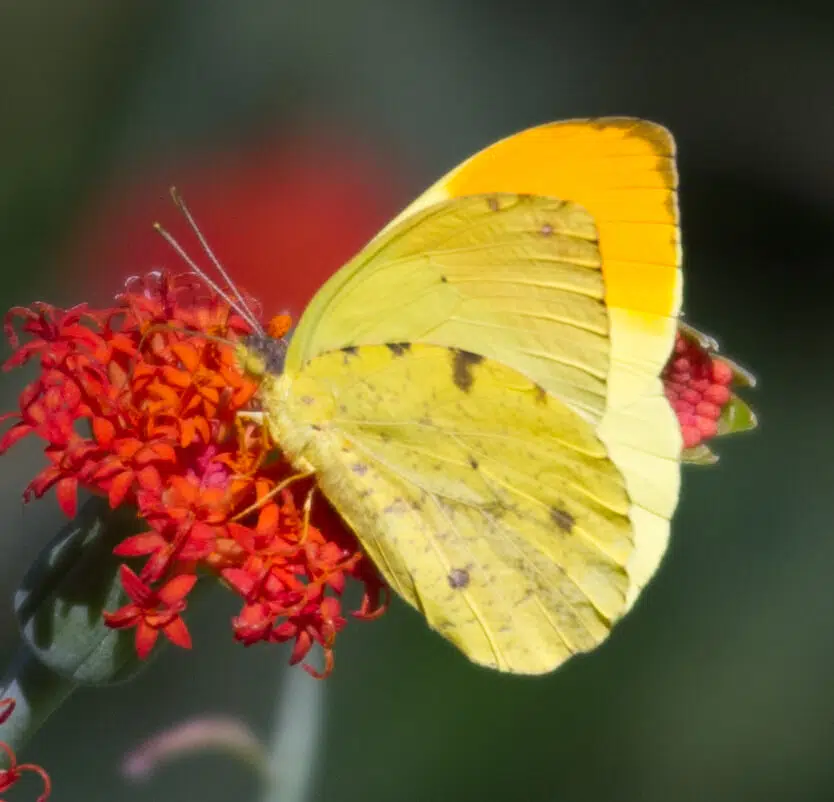
Also known as the orange-lemon butterfly, the Autumnleaf Vagrant butterfly (Afrodryas leda) looks like yellow leaves in the fall.
Males have a shorter wingspan than females. Their wings reach 55mm while female wings reach 56mm.
Both the male and the female have mostly yellow wings with orange coloring on the top.
This makes them blend in with the yellow leaves of the autumn which also inspires the name of the species.
Larvae of the species are commonly seen on the African caper it feeds on.
4. Blue oakleaf

The Blue oakleaf (Kallima horsfieldii) is common in India. This is a vividly colored butterfly with nuances of blue, black on a dorsal view.
However, the underside of the Blue oakleaf is completely brown, looking like a leaf. This butterfly is among the most difficult to spot even on green leaves as it simply appears as a dead brown leaf from a ventral perspective.
The only differences between males and females are the vividness of the blue coloring. Males have a slightly lighter blue coloring.
5. European peacock
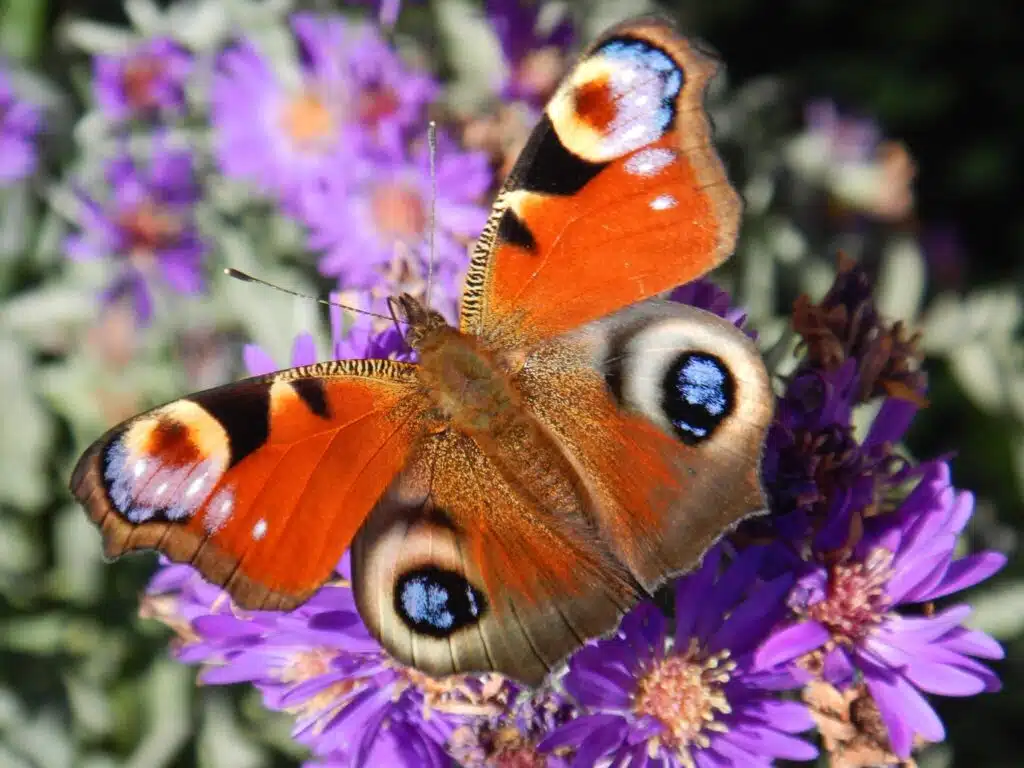
The European peacock (Aglais io) also looks like a leaf ventrally, just like the Blue oakleaf. This species is known for its vividly-colored wings that are as large as 55mm across.
European peacock butterflies have 4 eyespots on the dorsal side of blue, black, and white coloring.
However, their ventral side is all-brown with a texture similar to tree bark. This makes the butterfly look like a leaf ventrally.
The species are still common parts of Japan and Azerbaijan.
These butterflies are seen drinking flower nectar in the summer. They hibernate in the winter.
Most of their flight time is spent in woodland and meadows. These butterflies feed on flower nectar often being taken for leaves when viewed dorsally.
6. Common brimstone

Common brimstones (Gonepteryx rhamni) are one of the rare species of green butterflies. These are easily confused with many green leaves out in nature.
These butterflies are known for having slight coloring differences between the sexes. Males have yellow-green coloring while females have all-green wings.
With green coloring, these butterflies blend in with the environment being hard to detect by their natural predators.
Even Common brimstone larvae are known for having camouflage-like coloring. Butterflies of the species act like leaves when handled.
This defensive mechanism stiffens their wings and retracts their legs so that they look like a green tree leaf.
Common in North America, these butterflies are known for exhibiting a migratory behavior.
They breed in wetlands and then move inland towards woodlands as they turn into adults.
7. Cloudless Sulphur

This butterfly species (Phoebis sennae) is constantly confused with yellow falling leaves. It has yellow wings which can be spotted or not, depending on the sex.
Females have a brighter yellow coloring with 2 brown spots towards the top. Males have pale yellow coloring.
Yellow coloring makes them blend in with leaves that are also yellow.
These butterflies are common both in North America and in South America where they spend a lot of time on vividly-colored flowers.
These vivid colors help them blend in a bit better. Cloudless Sulphur butterflies are seen on cordia, hibiscus, wild morning glory, and other similar flowers.
8. Malayan Oakleaf
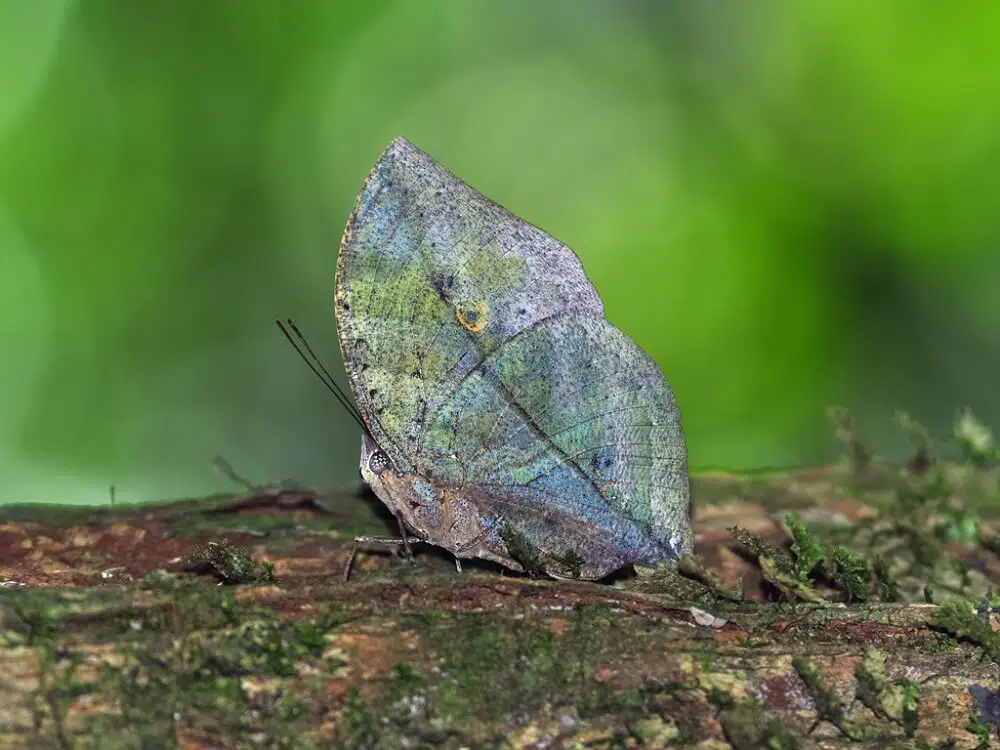
The Malayan Oakleaf (Kallima limborgii) is very common in Malaysia. This butterfly is known for its brown wings that are marked with white lines and darker brown spots towards the tips when viewed ventrally.
However, the butterfly has a brown spotted coloring dorsally.
Its brown coloring on the dorsal side of the wings is spotted with darker brown nuances.
The dorsal side of the wings is also characterized by visible yellow-brown nuances.
Its dorsal wings aren’t uniform brown which makes it appear more like brown leaves. The legs of the butterfly are also brown so that it blends in with tree bark and to be perceived as a tree leaf.
9. American snout

These black-brown butterflies (Libytheana carinenta) look like leaves and use their camouflage color to evade predators.
Often seen hanging upside down in trees or plants, the American snout is a distinct butterfly that looks like a leaf.
It has a long mouthpart that is of the same brown color as its wings.
Its atypical shape makes it resemble a leaf.
Their thin and long labial palpi are what makes these butterflies almost invisible when resting on grey or brown terrains as well as when they sit on trees and flowers.
American snouts are also known for a complex migratory process. Thousands of butterflies migrate together in a spectacular movement dictated by air currents.
10. Goatweed leafwing
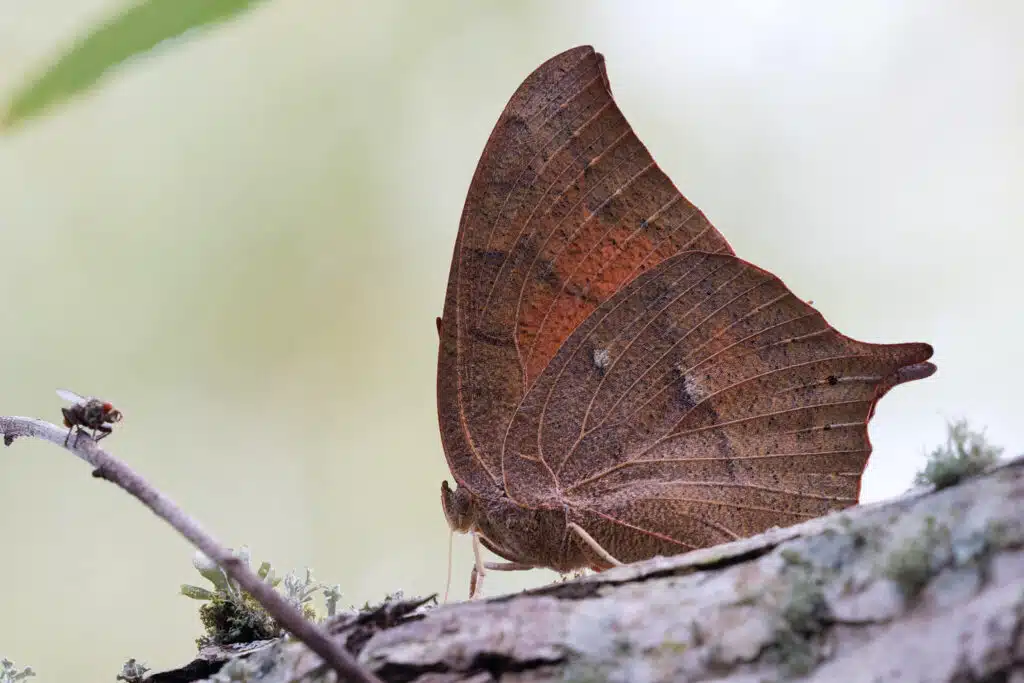
This butterfly (Anaea andria) is part of the Nymphalidae genus.
Commonly seen around fruit, these butterflies also eat dung and carrion. As part of its defense mechanism, it has orange-brown coloring.
Its underside is mostly brown with dark brown spots.
This butterfly looks like a leaf when its wings are close together. It often finds itself sitting upside down mimicking a leaf.
This butterfly also has other defense mechanisms. For example, it knows how to play dead.
It only plays dead when handled as a last resort and no other way to escape.
11. Tailed orange

The Tailed orange butterfly (Eurema proterpia) is found in Arizona, Texas, and parts of Mexico.
It lives in open woodlands and warm tropical climates.
This butterfly has a yellow-orange color.
The underside of the wings can match in color but it depends on the season. Tailed orange butterflies have a bright yellow underside in the summer.
This color darkens through the winter to a brown color with brown wing veins.
The butterfly has a shorter wingspan compared to other butterflies that look like leaves. Its wings expand to a maximum length between 32 and 44mm.
12. Sleepy orange

This butterfly (Eurema nicippe) is common in US states such as Florida. It’s mostly known for its yellow coloring which makes it stand out or blend in among yellow leaves and flowers.
Sleepy orange butterflies have a long flight season but they have a limited distribution across the US. They are mostly found around New York, New Jersey, and Ohio outside Florida.
Sleepy orange butterflies have a wingspan of at least 35mm. It can be as wide as 50mm.
There’s a coloring difference from males to females, as in most butterflies.
Male Sleepy orange butterflies are more orange than females. Most female Sleepy orange butterflies have a yellow-orange color.
Both sexes further exhibit brown markings on the wings which makes it appear as the butterflies would be fallen leaves.
The species has a long flight season that lasts all year.
13. Orange oakleaf
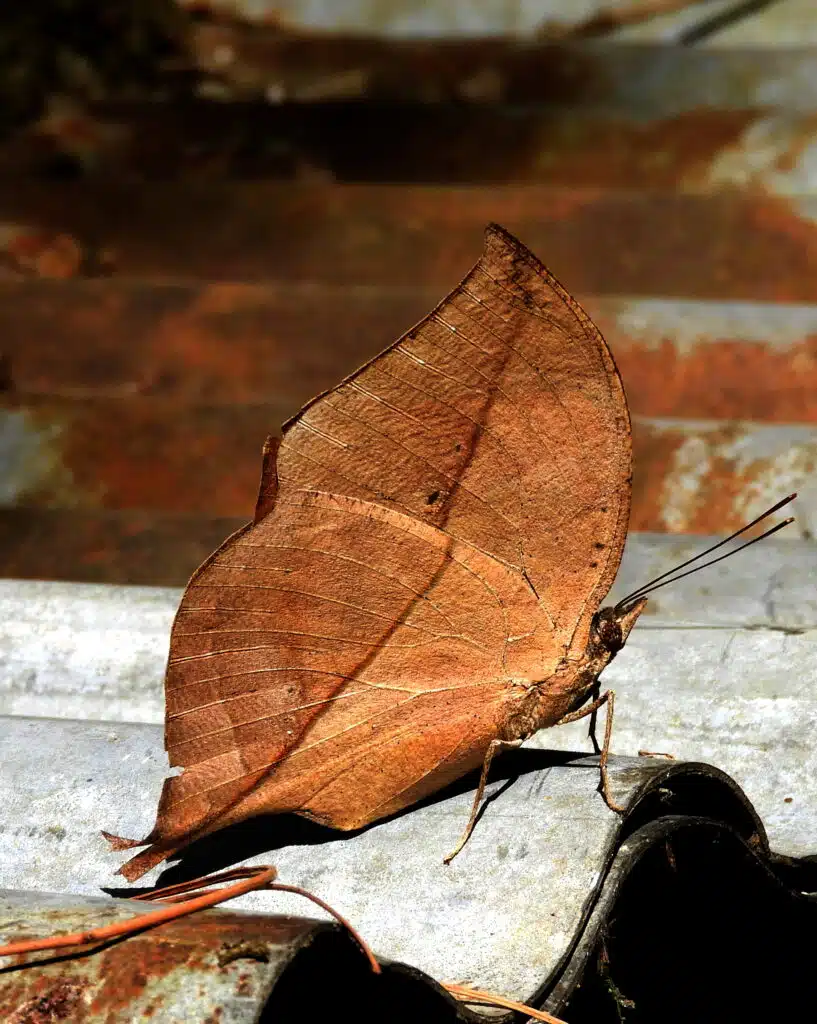
The Orange oakleaf (Kallima inachus) is common around India and Japan.
This common butterfly is known for resembling a leaf when it has its wings closed.
Its closed wings appear as brown with brown veins, just as the visible veins of a leaf.
Common around trees, the butterfly is seen consuming tree sap as well as ripe fruits. But fruits also attract birds and some of their natural predators.
Orange oakleaf butterflies have multiple defense mechanisms. It flies with frequent changes of direction to avoid predation.
Most importantly, this butterfly lands among other leaves and it closes its wings so that birds can’t see it.
Its immobile pose is believed to make it invisible to birds and even to some of its smaller predators such as spiders and some species of wasps.
When its wings are open this butterfly appears blue, yellow, and black. It has a long wingspan that stretched to a maximum of 110mm.
Further Reading: